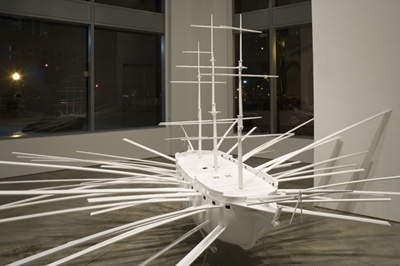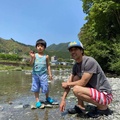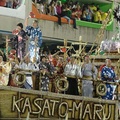Glenn Kaino (b. 1972) is one of the artists whose work is on display in the One Way or Another: Asian American Art Now exhibition at the Japanese American National Museum (the exhibition runs until May 4, 2008). His installation entitled “Graft” features two stuffed animals, one a salmon masquerading in shark skin, the other a pig cloaked in a cow’s hide. Simply wearing a mask is not a strong enough metaphor for social identity; here Kaino demonstrates the sometimes absurd lengths people go through to find place or acceptance.
Kaino primarily works with three dimensions, sometimes four if you include motion. The material he works with varies in accordance with his vision of the sculpture. He’s made a giant sand castle, an enormous contraption from items you might find in a garage sale, and a tricked-out pirate ship. His conceptual pieces are created to draw attention to contemporary social issues such as corporate greed, political consciousness and individual versus group identity.
Kaino is based in Los Angeles, CA. He received his B.A. from the University of California, Irvine and his M.F.A. from the University of California, San Diego. Some of the places that Kaino’s work has been shown include the Asia Society, New York; Whitney Biennial at the Whitney Museum of American Art, New York; and the Bronx Museum of the Arts. Kaino also started a Web site called uber.com that allows artists and other creative types to easily build their own Web page.
Glenn Kaino Interview
Where did you grow up? What kind of community did you grow up in?
I grew up in Cerritos, CA. It was very multicultural.
Were you creative as a kid? Did you draw and make stuff up?
I made my own toys as a kid, drew and painted from an early age and have been making art since age 12-13, with some seriously troubled youth years in between then and now.
When you went for your M.F.A. from the University of California, San Diego, what did you learn the most from school?
In both undergraduate and graduate school I learned about putting in the time to make good work, the dedication it takes, and the necessity to be rigorous in the application of both ideas and craft.
Who are the people you look up to and pull inspiration from?
Andy Warhol, Marcel Duchamp, Nancy Rubins, Robert Smithson, Claes Oldenburg, my
wife Corey Lynn Calter, Erwin Schrodinger, Jimmy Iovine, Chris Marker, Chris Burden, Subcommandante Ramona
Did your family support you in pursuing art or did they expect you to follow a different path?
My family has been very supportive of my practice. They are happy I graduated high school.
When you meet someone at a party and they ask you what you do, what do you tell them?
I say that I am fortunate to wake up and make things for a living.
Your art is visually stimulating but it makes people think. Sometimes the message is not so clear. Do you expect people to "get" your message? Does it bother you if they don't get it?
I make work to help articulate ideas that sometimes cannot be expressed in words. Unravelling and meditating about the work is vital to any 'message' and is the key to the process and life cycle of the work and its understanding.
An article by Sharon Mizota refers to "identity art." She writes, "If you were a Japanese American artist, you were expected to make art about being Japanese American." What do you think is worse: being pigeon-holed by the label, 'Japanese American artist' or shedding one's heritage for mainstream acceptance?
I think there is no better or worse, nor do I believe the issue and her framing of it is, respectfully, a simple boolean equation as you ask in your question. Being both a Japanese American who is also an artist inherently commits a context and framework for any type of production. Whether or not that context is applied and referenced in the actual work product, and how that effects the viability of the work depends heavily on the goals the artist has set out for both the work and their career. There are a lot of variables. I also wouldn't assume that mainstream acceptance is always the end goal, or what that even means. The art world and market is a very complex terrain to engage. Artists reference identity and also reach commercial success, those are not mutually exclusive in all cases.
As a writer, I've always had trouble writing about Asian American music because there are plenty of Asian American musicians, but really no such thing as Asian American music (a genre or sound). Is there such a thing as Asian American art?
You'd have to ask an academic about that, not me. I'm sure they would have some categories that they could funnel people into. I know that there is definitely American art created by Asian Americans, that's a fact.
What motivates you to create?
It's what I do. Don't know anything else but.
I noticed you have a MySpace page, but you haven't really used it. Not a question really, just wondering if you had any random thoughts about online social networking.
Had a MySpace page for research before I committed to build my site uber.com - check it out and let me know what you think. Social networking is cool if you want to network and be social. uber.com has those features but is made to facilitate people expressing themselves online. Made by artists.
© 2008 Bobby Okinaka







